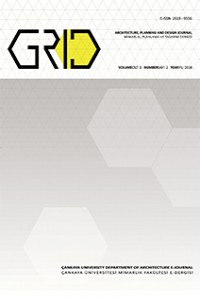Abstract
A literary product could be assessed as an architectural education material because every artwork has potential to be interchangeably used for explaining/introducing what the order is and how structure could be build via elements. In a literary product, author creates a pattern with the words similarly, an architect does the same with the architectural elements. Both of them have the same concern; to build an imaginative world. The more to be searcher as an inventory traveler between the wor(l)ds is the more to discover the way to use the language. Could the architectural student follow “how to make” with wor(l)ds as the masters who know “how to tell” with the stones? Are there any traceable paths between how to make (to build) and how to tell (write- rereading)? Two different texts constituted with spatial narrative elements will be used to make a nexus to architecture; poetic novel of Alessandro Baricco, “Ocean Sea” and Borges’s short story, “Library of Babel”. This comparative analysis signifies how spatial elements are capable to structure philosophy of the wor(l)ds.
References
- Bachelard, G. (1994). The Poetics of Space, translated by M. Jolas, Boston: Beacon Press.
- Baricco, A. (1999). Ocean Sea, translated by Alastair McEwen, New York: Knopf.
- Baricco, A. (2009). Okyanus Deniz, translated by Şemsa Sezgin, originally published in Italian, İstanbul: Can Yayınları.
- Benjamin, W. (2007). “The Storyteller”, Illuminations, translated by Harry Zohn, New York: Schocken Books, pp: 83-109.
- Borges, J. L. (2007), “Library of Babel”, Labyrinths: Selected Stories and Other Stories, New York: New Directions Publishing.
- Borges, J. L. (2000), “Babil Kitaplığı”, Ficciones, Hayaller ve Hikayeler, translated by T. Uyar & F. Özgüven, originally published in 1944, İstanbul: İletişim Yayınları, pp: 67-76.
- Borges, J. L. (1977). “Book of Sand”, Book of Sand, Dutton, retrieved from http://artificeeternity.com/bookofsand/
- Borges, J. L. (2009). “Kum Kitabı”, Kum Kitabı, translated by Yıldız Ersoy Canpolat, originally published in 1975, İstanbul: İletişim Yayınları, pp: 99-104.
- Chartier, R. (1994). “Libraries without Walls”, The Order of Books. Readers, Authors and Libraries in Europe between the Fourteenth and the Eighteenth Centuries, Stanford University Press, pp: 61-89.
- Manguel, A. (2008a). “The Library as Imagination”, Library at Night, New Haven/London: Yale University Press.
- Manguel, A. (2008b). City of words: Understanding Civilization through Story, Toronto.
- Psarra, S. (2009). “(Th) reading the Library: Spatial and Mathematical Journeys in Borges’ Library of Babel”, Architecture and Narrative: The Formation of Space and Cultural Meaning, New York: Routledge, pp: 89-109.
- Seligman, C. (1999). “Ocean Sea”, Book review published at 17 February 1999, retrieved from http://www.oceanomare.com/opere/oceanomare/ocean_sea.htm, accessed at January 2010.
Abstract
Yazınsal ürün, bir mimari eğitim materyali olarak değerlendirilebilir, çünkü her sanat işi, düzenin ne olduğunu, birtakım öğelerle yapının nasıl inşa edilebileceğini açıklamak üzere dönüşümlü kullanılabilecek potansiyele sahiptir. Bir yazınsal üründe, yazar kelimelerle bir örüntü yaratır, tıpkı bir mimarın mimari elemanlarla yaptığı gibi. Her ikisi de benzer kaygıyı taşırlar, hayali bir dünya inşa etmek. Kaşif gezgin olarak kelime-dünyalar arasında daha fazla araştırdıkça, dili kullanma biçimi daha fazla keşfedilir. Taşlarla nasıl söyleneceğini bilen ustalar gibi bir mimarlık öğrencisi de kelimelerle nasıl yapıldığını takip edebilir mi? Nasıl yapılacağı (inşa edileceği) ile nasıl söyleneceği (yazılıp-okunacağı) arasında izlenebilir patikalar var mıdır? Mimarlıkla bir bağ oluşturmak için mekânsal anlatı unsurları ile oluşturulan iki farklı metin kullanılacaktır; Alessandro Baricco’nun şiirsel romanı, “Okyanus Deniz” ve Borges’in kısa hikayesi, Babil Kitaplığı. Bu karşılaştırmalı analiz, mekansal elemanların kelime-dünyaların felsefesinin inşa edilmesinde nasıl yetkin olduğunu gösterir.
Keywords
References
- Bachelard, G. (1994). The Poetics of Space, translated by M. Jolas, Boston: Beacon Press.
- Baricco, A. (1999). Ocean Sea, translated by Alastair McEwen, New York: Knopf.
- Baricco, A. (2009). Okyanus Deniz, translated by Şemsa Sezgin, originally published in Italian, İstanbul: Can Yayınları.
- Benjamin, W. (2007). “The Storyteller”, Illuminations, translated by Harry Zohn, New York: Schocken Books, pp: 83-109.
- Borges, J. L. (2007), “Library of Babel”, Labyrinths: Selected Stories and Other Stories, New York: New Directions Publishing.
- Borges, J. L. (2000), “Babil Kitaplığı”, Ficciones, Hayaller ve Hikayeler, translated by T. Uyar & F. Özgüven, originally published in 1944, İstanbul: İletişim Yayınları, pp: 67-76.
- Borges, J. L. (1977). “Book of Sand”, Book of Sand, Dutton, retrieved from http://artificeeternity.com/bookofsand/
- Borges, J. L. (2009). “Kum Kitabı”, Kum Kitabı, translated by Yıldız Ersoy Canpolat, originally published in 1975, İstanbul: İletişim Yayınları, pp: 99-104.
- Chartier, R. (1994). “Libraries without Walls”, The Order of Books. Readers, Authors and Libraries in Europe between the Fourteenth and the Eighteenth Centuries, Stanford University Press, pp: 61-89.
- Manguel, A. (2008a). “The Library as Imagination”, Library at Night, New Haven/London: Yale University Press.
- Manguel, A. (2008b). City of words: Understanding Civilization through Story, Toronto.
- Psarra, S. (2009). “(Th) reading the Library: Spatial and Mathematical Journeys in Borges’ Library of Babel”, Architecture and Narrative: The Formation of Space and Cultural Meaning, New York: Routledge, pp: 89-109.
- Seligman, C. (1999). “Ocean Sea”, Book review published at 17 February 1999, retrieved from http://www.oceanomare.com/opere/oceanomare/ocean_sea.htm, accessed at January 2010.
Details
| Primary Language | English |
|---|---|
| Subjects | Architecture |
| Journal Section | Research Articles |
| Authors | |
| Publication Date | July 14, 2018 |
| Submission Date | March 22, 2018 |
| Published in Issue | Year 2018 Volume: 1 Issue: 2 |


